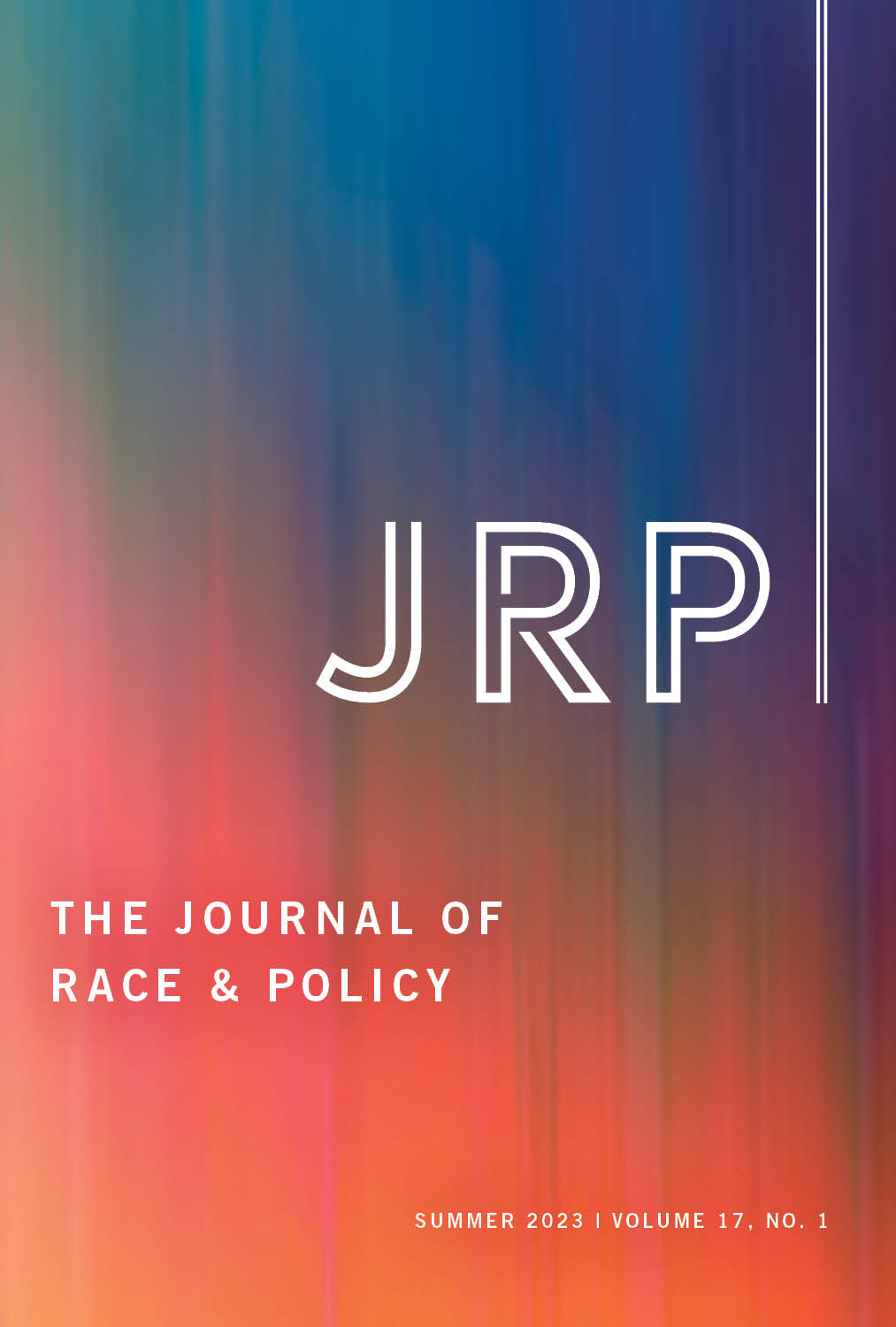Manuscript Submissions
The Journal of Race and Policy (JRP) is an interdisciplinary forum for the presentation of research dealing with education, employment, citizen participation, health care, social welfare, and social justice. Its objectives are to promote intellectual debate, scholarly investigation, and new ideas that focus on the intersection of race and policy in American society and in the global arena. JRP is especially interested in policy-oriented research employing innovative theoretical and methodological approaches. Articles for publication may be either from an academic or practitioner perspective and should contribute to the general public discourse and the scholarly community.
The journal is organized into two sections. Section one contains peer-reviewed research articles. The second section is for book reviews. Manuscripts dealing with race, multiculturalism, diversity, and global affairs are strongly solicited.
Compliance to Ethical Standards. Please note manuscripts will be evaluated for compliance to ethical standards. Any concerns that arise during peer review may require clarification from authors and/or lead up to rejection of the manuscript.
Book Reviews. Critical reviews of new and recent scholarly books should be no more than 6 double-spaced manuscript pages. Book reviews that are accepted for publication will be cut for length and clarity. The decision on the acceptability of a manuscript for the feature article category rests with the Book Review Editor of JRP. Book reviews are judged on the basis of importance of the work reviewed and the content, quality, and readership appeal of the review. Books reviewed should deal with some aspect of race and the intersection of policy. Authoritative discussions of policy, philosophy, problems, and significant controversies are appropriate. Comprehensive, timely review articles dealing with research and/or management topics also are pertinent. In the case of book reviews, it is suggested that inquiry about the book to be reviewed and the process be made prior to manuscript submission. Inquiries should go to the book reviews editor.
Style and Format. Research articles should be 25–30 double-spaced, typewritten pages. Longer manuscripts are evaluated based on whether their excellence justifies the additional space required for publication. Please include a maximum 100-word abstract, three to five keywords, and a brief biography. The article must be provided in Microsoft Word. Endnotes and tables can be embedded in the text of the submission, but images should be sent separately at 300 dpi. The documentation and stylistic standards must conform to the requirements of The Chicago Manual of Style, 18th edition, but will be altered to meet the needs of the journal. Past issues of JRP are the best resource on "how to" present items in your manuscript. Copies of the journal can be purchased by contacting the editor at mclemons@odu.edu. The preferred font style is Times New Roman. The manuscript should adhere to the following guidelines:
- 1) Abstract: Make sure your abstract gives a summary of the essential content and conclusions to the research performed. Abstracts should not be more than 200 words using 12-point Times New Roman. It should be placed below the manuscript title and authors' last names and institutions.
- 2) Authors: Full first names, middle initials, last names, and titles for all authors should be included on the first page, along with contact information (address, phone, fax, email) for all authors.
- 3) Sections: The journal manuscripts are organized into sections. Contributors are asked to pay particular attention to the utilization of theory and to show how their research engages extant theory. In addition, the statement of methodology should be detailed and clearly documented. For major sections use Title Case with a space below; for subsections use Title Case indented.
- 4) Tables and Figures: Place figure callouts <FIG 1 here>, captions, tables, and references within the body of the manuscript. Figures should be submitted separately. The source of the information should be indicated in the caption.
- 5) Text: In the text, use author's last name only, with date, and page number. Use “et al.” for three or more authors. For example: (Smith, 2003, 33); 2 authors: (Smith and Jones, 2004, 498–99). Lengthy quotes should be indented and single spaced, 12-point Times New Roman.
- 6) Notes and References: The notes and references sections should be placed at the end of the manuscript. The headings “NOTES” and REFERENCES” should be in all caps and both sections in 12-point Times New Roman. All references cited must be spelled out, accurately documented, and complete.
Please format references as follows:
a) BOOK: Smith, Bill. 2003. Title of Book. Place: Publisher.
b) BOOK WITH MORE THAN 2 AUTHORS: Smith, Bill, and Mike Jones, 2004. Title of Book. Place: Publisher.
c) EDITED BOOK: Smith, Bill, ed. 2003. “Title of Article.” In Title of Book. Place: Publisher.
d) JOURNAL ARTICLE WITH 1 AUTHOR: Smith, Bill. 2006. “The Title of Article.” Name of Journal 21 (3): 467–69.
e) JOURNAL ARTICLE WITH MORE THAN 2 AUTHORS: Smith, Bill, Mike Jones, and Mary Jane. 2004. “The Title of Article.” Name of Journal 21 (3): 467–69.
f) NEWSPAPERS (Internet source): Smith, Bill. 2005. “Title of Newspaper Article.” Title of the Newspaper, January, 28. Retrieved from http://the name/of the website/location.htm.
g) NEWSPAPERS (Hardcopy source): Smith, Bill. 2005. “Title of Newspaper Article.” Title of the Newspaper, January, 28, 1–2.
Also, any conferences, meetings, etc., should carry the full name of the conference, the paper title, if it was presented, and/or if it was included in the written proceedings, along with the date (month, day, and year) of the conference or meeting and the location where it was held. Include page numbers for book citations or meeting proceedings. All internet references will be checked for access; therefore, please provide a print reference to go along with the URL. If the author cannot provide a print version of the material found at the URL, the URL reference will be found in the text only—the same as a personal communication reference.
Notification of Status of Manuscript. Authors are notified of manuscript status within three to four months from the date manuscripts are received. If published, we inform authors of the issue in which the manuscript will appear. Accepted manuscripts are published no later than six to nine months from the date of acceptance. Reprints are available at a reasonable price. If further information is needed regarding the style and format of your manuscript, please contact Dr. Michael Clemons, editor of JRP via email at mclemons@odu.edu.
Manuscripts must address subjects of concern to the readership, be of current and ongoing interest, and be written in a readable style. All manuscripts undergo anonymous peer review by a minimum of two experts in the field. Occasionally, invited papers and/or special issues will be published. All submissions should be made via Scholastica.
It is assumed that any manuscript submitted for publication has been cleared, if clearance is required, by the author’s agency or organization and has not been published previously.
Manuscripts that are accepted for publication will be cut for length and clarity. Authors will have an opportunity to review all editorial changes prior to publication. An important emphasis of the journal is the presentation of a thorough review of the relevant literature in all published research articles. In addition to an extensive treatment of the scholarly literature and relevant theory, all manuscripts should test the stated hypothesis, address the research question(s) raised, and/or provide policy recommendations.
Because of space constraints, it is suggested that manuscripts not exceed 30 double-spaced manuscript pages, 12-point Times New Roman. This does NOT include graphs, tables, charts, or images, in addition to the text. Exceptions will be made on a case-by-case basis.
Review Process. Manuscripts are evaluated at submission to ensure adherence to journal guidelines. Manuscripts may be returned to authors for correction without substantive evaluation. Submitted manuscripts are then reviewed by the Editor, Associate Editor, and/or a member of the Editorial Board. An internal editorial review is completed based on priority to limit referee requests to those manuscripts that are likely to be accepted and/or fit JRP's mission and the interests of the journal readership. The Editor makes a final determination and forwards the final decision to the corresponding author.
Every effort is made to return unreviewed manuscripts within 10 days and reviewed manuscripts within 8–10 weeks. Papers submitted by members of the Editorial Review Board are handled separately by the Editor and undergo anonymous peer review. Manuscripts submitted by an Editorial Review Board member, an Editor, or a researcher at the institution of any Editorial Review Board member are reviewed by Editorial Review Board members from outside that institution. The Editorial Office ensures confidentiality and equity in reviewing all manuscripts.
Peer Review Statement
Essays submitted to the Journal of Race & Policy undergo anonymous peer review by at least two experts in the field.
Sample Exclusive licensing Agreement FORM
Editorial Board
Michael L. Clemons, Founding Editor, Old Dominion University
William H.L. Dorsey, Managing Editor, Atlanta Metropolitan College
Amardo Rodriguez, Book Review Editor, Syracuse University
Adolphus G. Belk Jr., Winthrop College
Richardean Benjamin, Old Dominion University
Micheal A. Boatwright, South Carolina State University
Shenita Brazelton, Georgia State University College of Law
Donathan L. Brown, Rochester Institute of Technology
Samuel Brown, Old Dominion University
Sharon D. Brown-Clemons, Norfolk Public Schools
Beverly A. Bunch-Lyons, Virginia Polytechnic and State University
Marvin Chiles, Old Dominion University
Alan Colon, Independent Scholar
Marvin P. Dawkins, University of Miami
Leroy G. Dorsey, University of Memphis
Bertis English, Alabama State University
Sekou Franklin, Middle Tennessee State University
Robeson Taj Frazier, University of Southern California
Helen Taylor Greene, Texas Southern University, Emeritus
Christopher A. House, Ithaca College
Kimberly James, The Headwaters Group, St, Paul, MN
Judson L. Jeffries, The Ohio State University
Ollie A. Johnson, Wayne State University
Charles E. Jones, University of Cincinnati
William G. Jones Jr., U.S. Dept. of Housing and Urban Development
Jonathan Leib, Old Dominion University
Kidane Mengistraub, Pennsylvania State University
Tracy Middleton, Benedict College
D'Andre Orey, Jackson State University
Adolph Reed, Jr., University of Pennsylvania, Emeritus
Mitchell Rice, Texas A&M University
Vanessa Sheppard, Georgetown University
Wendy Smooth, The Ohio State University
Karin Stanford, California State University–Northridge
Sherri L. Wallace, University of Louisville
To see the table of contents for the journal issues, visit the journal page on Project MUSE.
Code of Ethics
All OSUPress journals follow the Code of Ethics detailed here.




